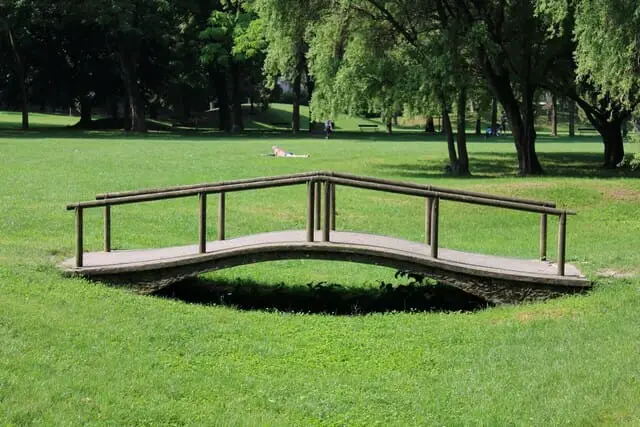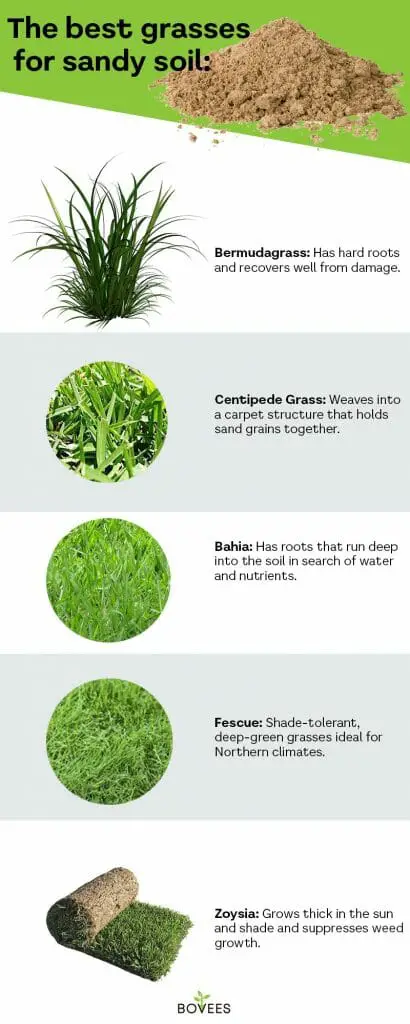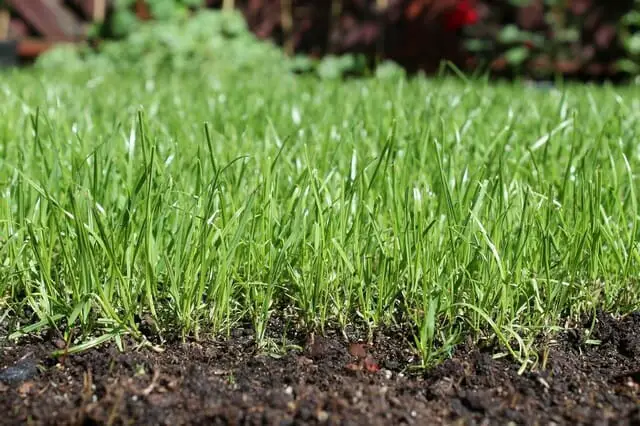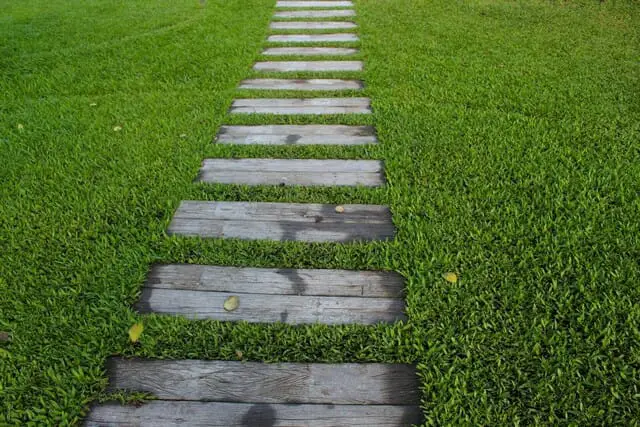Last Updated on June 15, 2023 by Grow with Bovees

Sandy soils are great because they drain easily, but they will unfortunately also lose nutrients quickly if you do not treat them right.
Plus, you will need to know exactly what type of grass will work to make the most out of your sandy soil, in order to grow a beautiful lush green lawn.
So, what do you do if you have sandy soil? And what is the best grass for sandy soil?
Check out these grasses, they are considered to be the best grass species to grow in sandy soil:
- Bermuda grass.
- Centipede grass.
- Bahia grass.
- Fescue grasses.
- Zoysia grass
- Carpet grass
- St. Augustine grass
Before we take you through a detailed discussion about the best grass for sandy soil, let us start by guiding you through, first, choosing the best grass for sandy soil.

How to Pick the Best Grass Seed for Sandy Soil
You will waste money and time on fertilizer and watering if you do not make absolutely sure that the grass you wish to grow is ideal for your sand soil.
Here are some tips for picking out the best grass for sandy soil:
Deep Root System
Growing grass in sand soil can be difficult because the soil is so porous. This means nutrients and moisture drain away quickly from the top layers of the soil, and the grass roots can’t reach it.
If you want to improve your chances of getting a thick, green lush lawn in sandy soil, pick and plant grass seed varieties that develop deep roots. They will draw in more moisture and nutrients from the soil, and you’ll need to water and fertilize less frequently.
Know Your Location
If you’re in the Northern states, and are dealing with sandy soil in your garden, a cool-season grass type, such as fescue grass, is ideal. Cool-season grass types can’t take hot summers, but they don’t get damaged during harsh winters.
For Southerners with sandy soil, go for warm-season grass types, such as bermuda grass and centipede grass.
They thrive in hot summers and mild winters and are often more drought-tolerant.
In the transition zone that extends through the United States between the warm and cool climates, growing a thriving lawn is a challenge.
Most grass types will have either poor heat or cold tolerance. However, some of the best grass seed for sandy soil, such as tall fescue and zoysia grass seed, can work well in this environment.
Know the Humidity and Heat Level
The most challenging aspect to grow grass in sandy soil conditions is usually maintaining water and nutrients, but your new lawn can also be vulnerable to fungal diseases.
Conditions such as brown patch and large patch develop in high heat and humidity, and both cool-season and warm-season grasses can be vulnerable to them.
If you don’t apply a fungicide in time, these patches connect and create large brown areas, robbing your lawn of its once beautiful dark green shade, which is unsightly and prevent your grass from growing.
Shade and Sunlight
Improve your lawn’s chances of survival with a variety that can tolerate some shade, as well as direct sunlight.
For example, bermuda grass needs at least eight hours of direct sunlight a day, while zoysia grass will survive with at least six.
Tall fescue grass can grow well with less, so it’s ideal when looking for lawn grass that grows in sand or loose soil and thrives in the shade.
Traffic
If you have kids, pets or a play area, consider growing grass that is a children-friendly variant, such as bermuda grass and zoysia.
They’re also ideal for high-traffic areas, such as sports fields, because they recover fast and withstand wear and tear.

So, What’s the Best Grass for Sandy Soil?
You should now have an idea of the type of grass you’ll need.
With this information in mind, check out these grass seed for sandy soil reviews:
Bermuda Grass
Bermuda grass is a warm-season grass that’s native to Africa, making it naturally heat and drought-resistant.
This is why it’s ideal to plant it in well drained soil and in areas of warm climates, with fair amounts of direct sunlight, such as in the southern US.
This grass type features a dark-green blade that looks good and endures heavy traffic well. Still, thanks to the fine leaves that grow from the bermuda grass seed, bermuda grass is soft underfoot, making it a perfect child-friendly option.
From the sandy coastline to material-rich loamy and clay soils, this warm-weather grass thrives almost everywhere. Bermuda grass has a deep root system that extends into the sandy soil, forming networks that absorb water and mineral nutrients.
Be aware that bermuda grass spreads aggressively both on the ground—through stolons—and below ground—through rhizomes—so it can take over flower beds and veggie patches.
To combat this, use a lawn edger to create clear borders and do active weed control, especially in the first weeks after seeding.
The deep root system of bermuda grass is extremely persistent, and will take over sandy yards if given half a chance!
Note that Bermuda grass grows and thrives under a lot of sunlight and goes brown under too much shade. Avoid sowing the grass seeds in the shade of buildings or trees or misty or cloudy environments.
Consider other grasses such as fescue grass seed if this applies to your garden.
Centipede Grass
Centipede grass is ideal as an affordable option that needs little care and thrives in sandy soil, warm areas and has good drought tolerance.
This grass grows well in quick draining sandy soils and infertile sandy soils. This is not the most attractive lawn as it has a color that is pale green, which isn’t to everyone’s liking, but if you try to make your centipede grass dark green with fertilizer, it can turn yellow.
Despite its relatively shallow root system, it doesn’t require frequent watering. Depending on the rainfall in your area, you may not need to water it at all.
This is why it’s sometimes called the “lazy man’s grass.”
While centipede is a spreading grass, it grows slowly by a shallow-rooted stolon. For this reason, the exposed stolons may freeze to completion during the winter season.
Besides, freezing temperatures, nematodes or roundworms can damage centipede turfs, making them appear weak and thin.
Also, if the roots are shallow and weak, the turf can wear out in a process called centipede decline. You can promote stronger roots with less-frequent watering.
Bahiagrass
Bahia grass seed originally arrived in the United States from Brazil. Today, it’s common in the southeast, especially in the infertile sandy soil of Florida.
Thanks to its resilient root system, it’s a low-maintenance turf with amazing resistance to both drought and heat.
It doesn’t need much watering or fertilizer, and since it’s low-growing, you don’t have to mow regularly. This grass type thrives well in well drained soil.
But, bahia grass seed doesn’t form a very dense lawn and is able to go dormant and stop growing in a drought.
What some people don’t love about bahia grass is that it forms a distinctive V-shaped seed head that doesn’t necessarily look attractive.
However, the seed heads allow it to reseed itself if you leave it alone.
Fescue Grasses
Fescue grass types are popular cool-season grasses in the Northern Midwest and New England. They’re ideal when looking for drought and shade-resistant grass with deep roots that can find nutrients and moisture in sandy soil.
These are the best types of fescue grass varieties for sandy soils.
Tall Fescue
Tall fescue is the epitome of resilience and durability. It adapts to a wide range of climates and tolerates heat, drought and shade, but is best in sunny areas and well drained soil.
These cool-season grasses stand out for their rich, dark-green color. If you seed densely enough, tall cool-season fescue grass grows into beautiful turfs with a fine, soft texture.
On the negative side, tall fescue is slow to grow. It doesn’t recover well if it gets damaged, and you may need to reseed. It’s also vulnerable to brown patch, so it’s not best suited for hot and humid locations.

Fine Fescues
Fine fescues, such as hard fescue and creeping red fescue, have fine, soft leaves and adapt well to conditions of partial shade or full shade.
They are one of the best grass types for sandy soil options for cold climates, but they won’t survive high heat like southern lawns.
Hard fescue is a dark-grayish green grass that thrives in low-fertility sandy soil and requires low maintenance and mowing.
Hard fescue also does well in both the drought and cold, making it ideal for cool climates with low rainfall.
Although it doesn’t need much water, this cool-season grass doesn’t survive the heat and will take a long time to recover if it gets damaged, though.
Many people say that this is the best grass for sandy soil in a cool climate.
Creeping red fescue is equally slow-growing and low-maintenance. The grass grows well in sandy soil, even mountainous environments.
This thin-bladed, soft turfgrass also requires low to no mowing, fertilization or watering.Note that you can use two cool-season grass seed types, such as creeping red fescue and Kentucky bluegrass, together to increase the lawn’s shade-tolerance.
Zoysia Grass
Zoysia grass seed develops a thin-bladed grass lawn native to Asian countries. Zoysia grass seeds grow best in warm areas, especially the southern two-thirds of the US. Unlike many other warm-season grasses, zoysia grass endures traffic and shade.
It also has good drought tolerance once you have this lawn established, which can take a couple of years.
The roots grow deep to form a network that absorbs moisture from soils, making it ideal for sandy lawns. Zoysia grass seed, as it grows and develops, forms a thick, green turf that doesn’t leave room for weeds.
Zoysia grass, much like other warm season grasses, can survive cold temperatures and does well under both shade and sunlight.
Also, its low-growing blades can be fine or coarse, but they tend to be stiff. This means more work when you’re mowing and even sharpening your lawn mower blades more often.
Note that zoysia browns and goes dormant quickly after the first frost; this is its major downside. Otherwise, zoysia guarantees value for money when looking for a tough grass seed for sandy soil.
Another thing to keep in mind is that this type of grass seed may be difficult to find and it is most commonly sold as grass plugs or sod.
Carpet grass
Axonopus fissifolius — which is the scientific name for carpet grass — is another type of grass that thrives well in sandy soils.
It is a perennial grass which grows in a mat-like form and belongs to the Poaceae family. Its natural habitat is the sandy soils of the southeastern parts of North America. This grass type has, however, become natural in a lot of other parts of the world as well.
This warm-season grass is often used as lawn or pasture and is valued for its ability to grow and survive in difficult areas. These areas include boggy and shaded areas. Grow this grass by sprigging or by planting carpet grass seeds.
Carpet grass does not require highly fertile soil and has a low tolerance for ongoing traffic. This makes it the perfect lawn for low-maintenance landscaping areas.
Once carpet grass is established, it can reach a height of approximately 8-10 inches (20-50 cm), spreading with both stolons and rhizomes. This grass type has a naturally shallow root system and is able to seed profusely.
St. Augustine grass
St. Augustine grass, scientific name Stenotaphrum secundatum, is another sandy soil loving grass type. This one is also a perennial grass and has a low mat-forming growing habit.
It is native to Central America as well as southeastern North America. It has, however, naturalized along a lot of coasts across the globe.
St. Augustine grass is a warm-season grass which is quite popular for its attractive leaves, and it is often grown as lawn grass in places that have a tropical climate.
It grows best in an environment that is moist and is not that tolerant to drought.
These grasses have attractive dark green leaf blades that have a coarse texture, they have a broad but flat appearance, and they spread via roots and stolons. St Augustine grass can be made to spread quickly if you know how to do it.
Plant St. Augustine grass in sandy soil that has a soil pH which is slightly acidic, and your grass will be happiest.
Compacted clay soil is an absolute no-go, due to the lack of oxygen that is found in this type of soil. Sufficient oxygen is needed to support the growth of this type of lawn grass.
How to Get Your Sandy Yard Ready For Grass
When you’ve picked the best grass seed for sandy soil, you’ll need to prepare your yard correctly to get that lush, healthy lawn.
These steps will help you get it just right.
PH Test and Compost to Improve Your Lawn
Sandy soils are naturally more alkaline, while clay soil retains more acidity. To keep pests and bacteria at bay, you should try to keep your soil slightly acidic to neutral, at a pH between 5.9 and 7. You can provide more acidity to your soil with composting.
The soil’s acidity also affects how grass absorbs water and minerals. To avoid guesswork, gather sample soil from various parts and depths of your yard. Then, try a DIY kit to test your soil’s pH and nutrient balance.
Organic matter, such as compost or peat moss, increases the soil’s capacity to store and supply essential nutrients. The nutrients improve soil fertility and help the grass grow stronger, greener and thicker.
Seeding a Lawn on Sandy Soil the Right Way
This is how to apply the grass seed on your sandy soil:
- Break up the top 6 to 8 inches of soil with a tiller, spade or garden rake.
- Remove rocks and weeds that might prevent the new plants from growing.
- Mix 3 to 4 inches of organic matter, compost or manure to give nutrients back into the soil.
- Use lawn starter fertilizer before sowing the grass seed, mixing it into the top inches of soil.
- Check the amount of grass seed you’ll need. Each brand and type of grass will have different specifications.
- Apply the grass seed by hand, or with a spreader if your lawn is big. Do it first in vertical rows, then horizontally to cover everything. Make sure that you spread the seeds evenly.
- Rake gently to get the grass seed in the ground to prevent birds from picking the seeds.
- If your grass seed doesn’t include mulch, apply some, but only a light layer.
- Water as below.
How to Water a New Grass Seed
For the first two weeks, you’ll need to water the soil at least once a day to ensure it remains moist, making sure not to saturate the soil. You’re germinating a grass seed, and you won’t succeed if you let it dry out.
If it’s dry and windy, you might need to water more than once a day until the grass starts to grow all over.
How To Maintain a Beautiful Sandy Lawn

Level-Up Your Yard With These Methods
A beautiful yard is about more than just maintaining your grass. These are some other ways to make your yard more appealing:
- External lighting: Add lights for a cozier environment at night.
- Outdoor furniture: Create comfortable areas for relaxing with yard furniture.
- Planting trees: Trees like ash, mulberry and oak as well as fruit trees thrive in sandy soils and help stabilize the soil.
- Planting shrubs: Shrubs and flowers, such as juniper and sage, in empty patches of yard, can make your yard look more appealing and grow well in dry conditions.
Go For a Rock Garden!
A rock garden with suitable plants can be a lifesaver if you’re living in a harsh climate, and it can change the garden’s dynamics. A well-thought-out rock garden can combine well with grass or work on its own.
Creative combinations of large stones, pebbles, rocks and boulders add diversity, but you can put some plants to the mix!
Different species of cactus and aloe vera will survive even dry Southern climates and dry sandy soils.
Conclusion
There’s no single best grass for sandy soil. The right grass for you depends on the weather, sunshine, foot traffic and sandy soil pH levels. This way, you can create a lush and green yard while putting less time into maintenance.
Once you’re set on a grass type, make sure you pay attention to how to grow grass in sandy soil. Prepare your yard before seeding and water frequently for optimal growth of the grass.
Which is your favorite grass for sandy soils? Let us know in the comments!
Happy planting!
Resources;
https://aggie-horticulture.tamu.edu/plantanswers/turf/publications/Centipdecline.html


